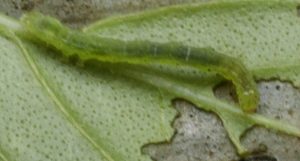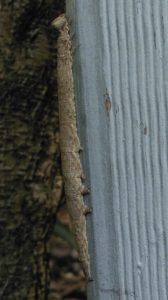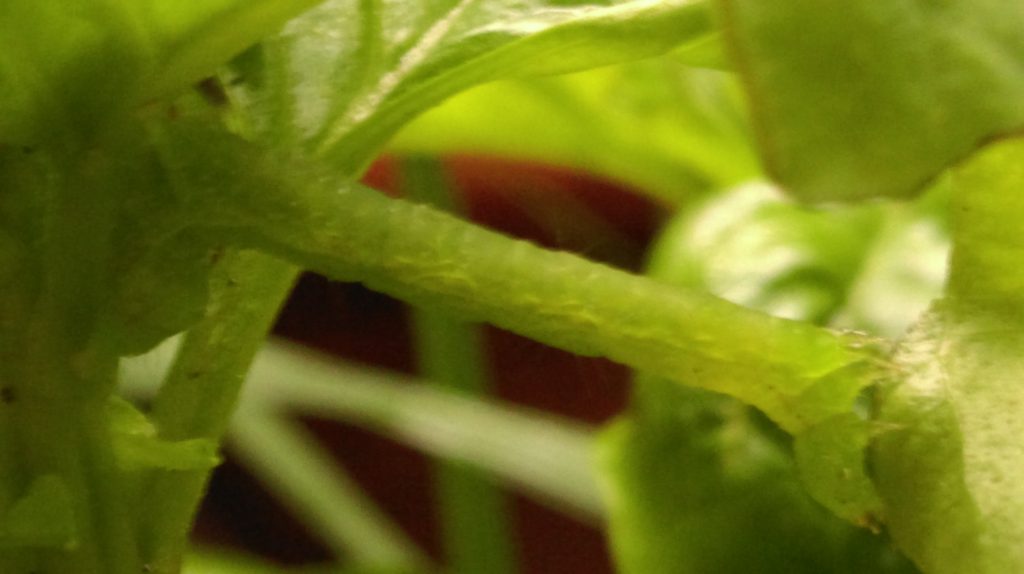[wysija_form id=”2″]
Looking at this caterpillar, in a basil plant, it is tempting to ascribe it intentions that it does not have. Certainly it has brilliant camouflage, not only in its colour but in its twig-like behaviour, but is it intending to deceive a predator? Is it deliberately hiding in greenery; has it decided to act like a twig?
In humans, hiding and deception are capacities that develop over time. It is this sense of growing capacity that makes the game of hide and seek so thrilling for children. Another game that parents play, using their hands to cover and then reveal their own face, is a precursor to hide and seek. Even babies can engage in it because it only requires of them a relation with another present being, a responsive capacity that is available from birth. Hiding is another matter. It requires self-consciousness; the child must be able to imagine how they look to another, to identify with that image (i.e. have a concept of self), and to manipulate that knowledge to advance their own interests (i.e. have a series of abstract goals that they hope to achieve).
 If we presume that the basil-eating caterpillars are incapable of self-consciousness, their lives are able to produce the effect of hiding without the individual animal having the capacity to hide. This occurs because ecological relations allow them to do things with and through their environment that they cannot do themselves. For such animals, camouflage is not an individual or a species capacity but an ecological affordance that has been developed through the evolutionary process of natural selection. The caterpillar does not freeze in order to hide from the predator that has approached. It freezes because that is its naturally selected response to certain sensory triggers that are associated with fear or danger or the beings that we would call predators. If the caterpillar is in its preferred environment, its relation with the environment gives that response the effect of hiding.
If we presume that the basil-eating caterpillars are incapable of self-consciousness, their lives are able to produce the effect of hiding without the individual animal having the capacity to hide. This occurs because ecological relations allow them to do things with and through their environment that they cannot do themselves. For such animals, camouflage is not an individual or a species capacity but an ecological affordance that has been developed through the evolutionary process of natural selection. The caterpillar does not freeze in order to hide from the predator that has approached. It freezes because that is its naturally selected response to certain sensory triggers that are associated with fear or danger or the beings that we would call predators. If the caterpillar is in its preferred environment, its relation with the environment gives that response the effect of hiding.
We ofte n describe such an affordance as a species’ successful evolutionary strategy. But this is to speak loosely; there was no strategy. There is only a long species history of environmental relations, during which most genetically-predisposed responses were eliminated. If the basil-eating caterpillar moves to a different environment, tries to eat a different plant, its clever ‘strategies’ might now endanger its existence. It can become a fish out of water. The caterpillar on the left, for instance, was perfectly matched in colour and shape to the wisteria vine upon which it usually lived. But it lacked the self-consciousness to realise how dangerously conspicuous it became when it moved from the wisteria to the blue painted post around which the wisteria climbed.
n describe such an affordance as a species’ successful evolutionary strategy. But this is to speak loosely; there was no strategy. There is only a long species history of environmental relations, during which most genetically-predisposed responses were eliminated. If the basil-eating caterpillar moves to a different environment, tries to eat a different plant, its clever ‘strategies’ might now endanger its existence. It can become a fish out of water. The caterpillar on the left, for instance, was perfectly matched in colour and shape to the wisteria vine upon which it usually lived. But it lacked the self-consciousness to realise how dangerously conspicuous it became when it moved from the wisteria to the blue painted post around which the wisteria climbed.
I think humans are more like these camouflaged caterpillars than we like to acknowledge. We routinely ascribe to clever strategy outcomes that actually come from responsive relations and ecological affordance. Without these responsive relations the baby could not have initially developed the selfhood upon which strategy is based. But, more than that, this capacity for unself-conscious and ecologically-embedded response continues to give adults capacities that they could not attain themselves.
Andrew
